Welcome to the Hadassah Tour
Before we begin, apologies for the delay in getting this page up for your viewing pleasure. We ran into significant internet delays on our last day in Jerusalem, and in Ein Gedi the last two days we had no access at all (gasp!). Now we are in Eilat, the Miami Beach-Los Angeles-New York of Israel (don't be fooled when people say Tel Aviv is; this place really never sleeps).
Ironically, for such a lively place, it's not that advanced in terms of internet access. Tel Aviv's and Jerusalem's internet cafes both had T-1 lines (the kind of really fast access you get at work, if you're lucky), but BJ's Books, where I'm now sitting, has only three PCs and a regular ISDN connection (and it's much slower).
For example, we tried to upload photos from Ein Gedi and the Dead Sea, but it took forever to get 4 photos uploaded, and then the server connection died. So, we gave up on that and decided simply to update this page. We'll try again later to upload Ein Gedi, etc.
FYI, the text that follows is courtesy of Adam, who wrote it on a basic text notepad in Jerusalem on Monday while I was busy trying desperately to upload photos and program the HTML. As I said, the internet access was slow, but at least the PC's notepad function was its regular fast speed.
Also, for our loyal fans, we apologize as well for the fact that we haven't been able to access Hotmail for the last few days, and now, for some reason, we can't access it here. The proprietor here, Jeff, says Hotmail has had problems all week (I can believe that, given that we had problems on Monday in Jerusalem as well). Still, it's frustrating!
Anyway, without further ado...
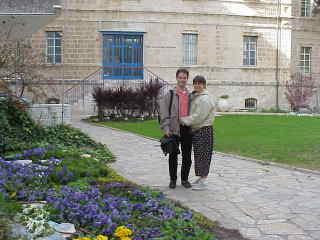 Adam here again. On Sunday, Monica
and I took the Hadassah half-day tour.
Hadassah is a Jewish women's Zionist
organization founded to raise money
and provide assistance to Israel.
Adam here again. On Sunday, Monica
and I took the Hadassah half-day tour.
Hadassah is a Jewish women's Zionist
organization founded to raise money
and provide assistance to Israel.
(An image of us in front of the Hadassah College of Technology is to the right.)
As we learned on the tour, the
organization was founded by 12
young women
who noted how poor the health
conditions in Palestine were
at the time.
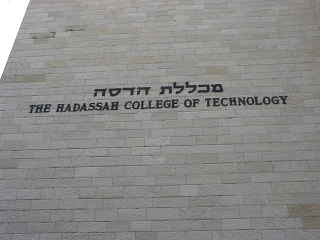 At the beginning, they had just two nurses, and a
donkey who carted medicines around to the poor. Today,
Hadassah is the largest membership association
in the United States (according
to the tour guide, although I think the
Red Cross is actually larger;
maybe she meant the largest Jewish
organization in the U.S.).
At the beginning, they had just two nurses, and a
donkey who carted medicines around to the poor. Today,
Hadassah is the largest membership association
in the United States (according
to the tour guide, although I think the
Red Cross is actually larger;
maybe she meant the largest Jewish
organization in the U.S.).
To the left is the original building for Hadassah in Jerusalem, sold to Hadassah by the Rothschilds for only $1 (with the understanding that they would keep the nameplate on the building).
It is now the
Hadassah technology college, one
of the most respected technical colleges
in the country.
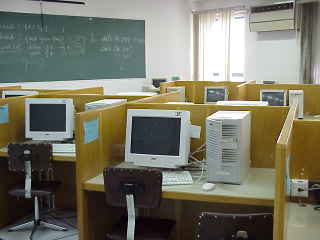 As you can see, the college is highly
technology-oriented, with almost all
programs (including art and
photography) teaching on the computer.
As you can see, the college is highly
technology-oriented, with almost all
programs (including art and
photography) teaching on the computer.
One of the things Monica appreciated about the computer center was
its computer that was outfitted for blind students; it tells people
what they have typed, and even prints in braille. (Monica asked if
there is a different Braille in Hebrew, but apparently there is not;
Braille is a purely English language.)
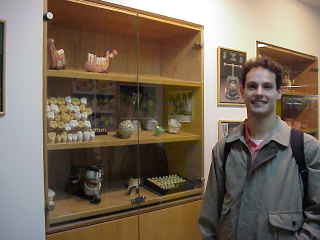 The image to the right is of Adam in front of an exhibit of
the school's dental technology program.
The image to the right is of Adam in front of an exhibit of
the school's dental technology program.
This program teaches students to create prosthetic devices and use dental examination equipment.
We took this picture and the one below
primarily for Aunt Naomi and Uncle
Irv Eichenbaum (both of whom are dentists).
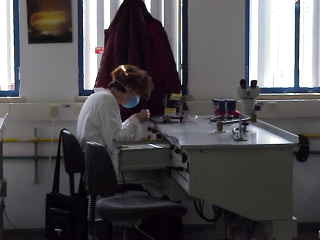
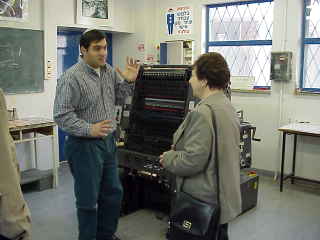 For Monica, as she is a publisher, the school's program in
how to use a printing press was quite interesting.
For Monica, as she is a publisher, the school's program in
how to use a printing press was quite interesting.
Hadassah has a Heidelberg Press printing system for their printing courses. It also has students print publicity and informational brochures as final projects, thus reducing printing costs. Smart thinking!
In the picture to the right, the printer explains to our tour
guide Miriam what he is doing.
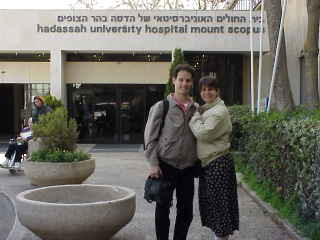 After touring the techology college, we went to the Mt. Scopus
branch of the Hadassah Hospital.
After touring the techology college, we went to the Mt. Scopus
branch of the Hadassah Hospital.
This is the obligatory picture of Monica and me in front of the Mount Scopus Hospital in the hills of Jerusalem.
By the way, for those
of you who don't know, Grandma
Libbie Zucker is among the Redeemers of
Mount Scopus for her charitable
work with Hadassah and her generous gifts.
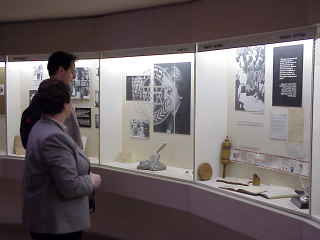 Henrietta Szold was the
founder and guiding force behind
Hadassah. She never married,
instead dedicating her life to improving
Palestine (in those days, it
was hard both to marry and to have a career).
Henrietta Szold was the
founder and guiding force behind
Hadassah. She never married,
instead dedicating her life to improving
Palestine (in those days, it
was hard both to marry and to have a career).
In a room of the hospital,
they have preserved her old desk and
memorabilia from her office. Ms.
Szold unfortunately died before her dream
for the independent state of Israel
could be realized. She passed away in
1945; the country declared its
independence in 1948.
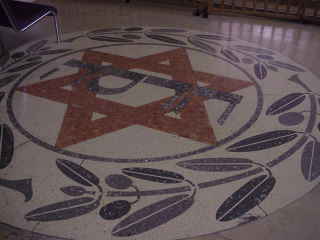 This Hadassah mosaic sits in the center
of the main floor of the hospital.
This Hadassah mosaic sits in the center
of the main floor of the hospital.
When eastern Jerusalem fell to Jordan during the War of Independence, the hospital was more or less destroyed.
When Israel won back Mount Scopus
with the rest of the territories in
1967, the mosaic had "miraculously survived," as our tourguide
Miriam said; it was all that
Hadassah could salvage of the old hospital.
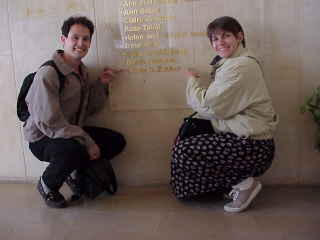 As of last year, Grandma Libbie is also a
Hadassah Founder.
As of last year, Grandma Libbie is also a
Hadassah Founder.
There she is (in the photo to the right, and in the photo below) on the wall for posterity.
We saw some hospital
patients who I am sure are very greatful
for Grandma's support of the hospital.
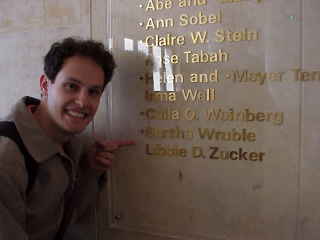
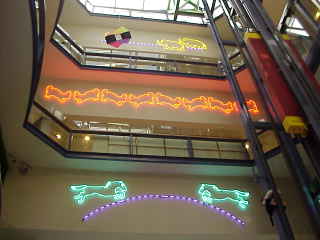 After Mt. Scopus, we were driven to the Ein Kerem
branch of the hospital, which opened in the 1950s after
the Mt. Scopus branch was lost to the Jordanians in the
War of Independence.
After Mt. Scopus, we were driven to the Ein Kerem
branch of the hospital, which opened in the 1950s after
the Mt. Scopus branch was lost to the Jordanians in the
War of Independence.
Originally, the Ein Kerem hospital was some distance outside of the city, but when Ben Gurion allocated the land for it many years ago, he prophetically said, "You build your hospital, and the city will grow to meet it."
He was right and then some.
Since Granny was last here, the
hospital has opened a new chidren's wing.
It has bright, cheerful decorations and
looks a bit like Disneyworld.
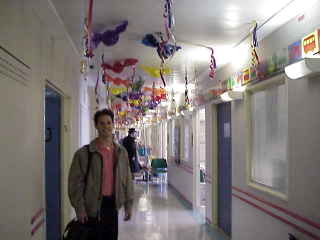 Inside the hallways, the wing was still
decorated for Purim.
Inside the hallways, the wing was still
decorated for Purim.
I'm not sure you can see in the picture, but the decorations hanging from the ceiling are supposed to be candies.
The guide noted
that although all the children are ill,
she rarely hears children crying in the
building.
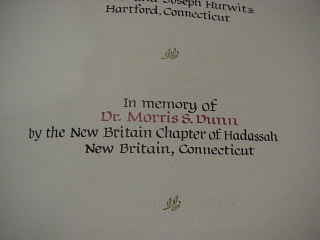 Dr. Morris Dunn (see the Kibbutz section
of the Web page) also has his name
inscribed in the memory book in the
auditorium of the building.
Dr. Morris Dunn (see the Kibbutz section
of the Web page) also has his name
inscribed in the memory book in the
auditorium of the building.
This is the same building in which the famous Chigall windows are installed, but unfortunately we couldn't take pictures in the synagogue. We had a lively tour guide for the windows who went through and explained the symbolism in each one. She got really excited about them.
For those of
you Washingtonians who can't visit Israel
any time soon, you can visit Grandma Libbie
and see her excellent needlepoint
representations of the windows. Of course,
they don't glow like the real thing.
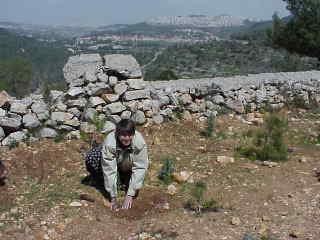
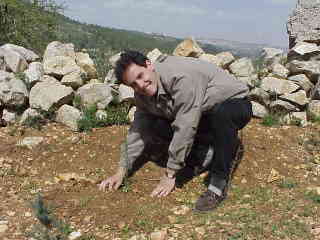 Along with the price of the half-day tour,
we got to plant trees in the Hadassah garden.
This method of donation combined with the
work of many hands turned Israel, once
largely a desert country, into a green and
prosperous land. I can see from touching the
soil how hard it must be to make anything
grow here. The soil is extremely dry and
quite rocky.
Along with the price of the half-day tour,
we got to plant trees in the Hadassah garden.
This method of donation combined with the
work of many hands turned Israel, once
largely a desert country, into a green and
prosperous land. I can see from touching the
soil how hard it must be to make anything
grow here. The soil is extremely dry and
quite rocky.
Click below to see what we did in the following places (please note that it may be awhile before we upload another page, given how slow the process has been here; we're really sorry!)...
Last updated March 24, 1999.